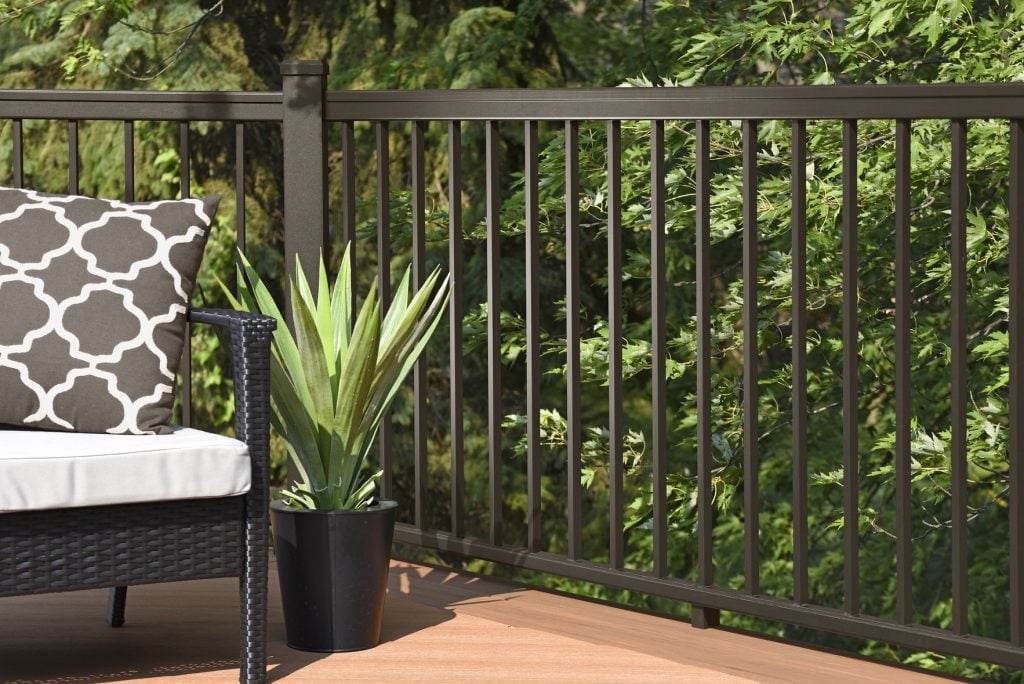When it comes to enhancing the aesthetic appeal and safety of your outdoor living space, choosing the right deck railing is crucial. Two popular options that homeowners often consider are composite deck railing and aluminum deck railing.
Both materials offer unique advantages and some drawbacks. In this blog post, we’ll cover the differences between composite and aluminum deck railings, exploring their pros and cons, as well as the price differences to help you make an informed decision.
Composite Deck Railing
Pros:
- Aesthetic Appeal: Composite railing comes in a variety of colors and styles, mimicking the look of natural wood without the maintenance.
- Low Maintenance: Unlike wood, composite materials don’t require painting, staining, or sealing. They are resistant to rot, decay, and insect infestation.
- Durability: Composite railings are designed to withstand harsh weather conditions and are less likely to warp, crack, or fade over time.
- Price: Composite railing systems are generally slightly less expensive than aluminum options.
- Curves: Some composite deck railings such as Trex Transcend Railing can be bent by experienced experts to match the curves of your deck.
Cons:
- Size: Composite railing systems are generally bulkier similar to a traditional wood deck railing.
- Heavier: Composite materials are typically heavier than aluminum, which can make installation more challenging.
Aluminum Deck Railing

Pros:
- Durability: Aluminum railings are extremely durable, resistant to corrosion, and can withstand harsh weather conditions without rusting or deteriorating.
- Low Maintenance: Aluminum railings require minimal upkeep. They don’t require painting or staining and are easily cleaned with soap and water.
- Lightweight: Aluminum is lighter than composite, making it easier to handle and install.
- Fast Install: Quality aluminum deck railing kits such as TimberTech Impression Rail Express offer panelized railing systems that do not require assembling and fastening each baluster.
- Size: Deck railings made from aluminum tend to look less bulky. Due to the strength of aluminum they are often manufactured with smaller components which provide a minimalist look.
Cons:
- Limited Styles: While aluminum railings come in various designs, they may not offer the same natural look as composite or wood railings.
- Thermal Conductivity: Aluminum can become hot to the touch when exposed to direct sunlight, which may be a consideration in warmer climates.
- Cost: Aluminum deck railings are generally a little more expensive but the low maintenance and long lifespan make them a good investment.
Price Difference
The cost of deck railing systems can vary widely depending on the quality, design, and complexity of the installation. On average:
- Composite Deck Railing Kits: Prices can range from $40 to $60 per linear foot for materials.
- Aluminum Deck Railing Kits: Prices are typically lower, ranging from $70 to $100 per linear foot for materials.
Conclusion
When choosing between composite and aluminum deck railings, consider the overall style of your deck, your budget, and the level of maintenance you’re willing to commit to. Composite railings provide a more traditional wood-like appearance. Aluminum railings provide added strength, durability and ease of installation. Ultimately, the best choice will depend on your personal preferences and the specific needs of your outdoor space.
